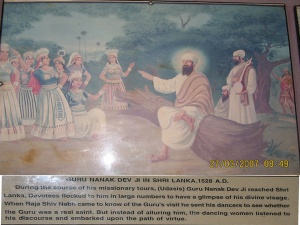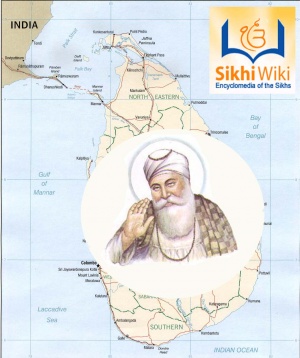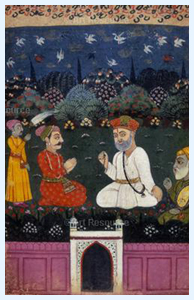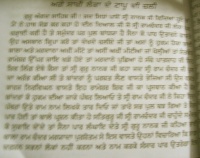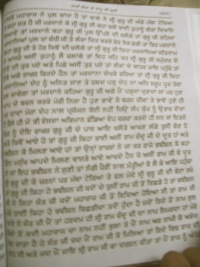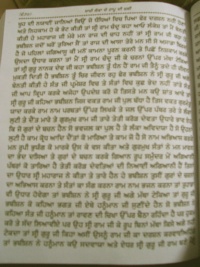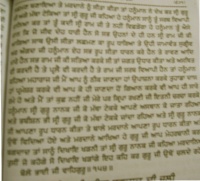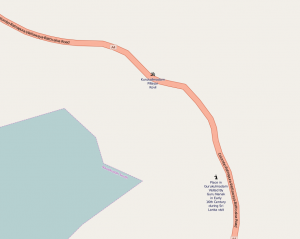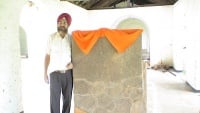Guru Nanak in Sri Lanka
Guru Nanak, the founder of the Sikh religion, like the Buddha earlier, sowed the seeds of spiritual democracy. The process of its germination and growth is still in progress and continues to flourish due to the Guru's message for the world at large, conveyed through his writings and personal visits to the then known countries of the Asian sub-continent.
This paper seeks to examine the historicity of Guru Nanak's visit to Sri Lanka. The Guru, possessing neither territory, nor wealth, nor aided by the forces of arms, preached his doctrine of peace in the countries during the course of his travels including Sri Lanka.
The paper concludes that much evidence, in both written and oral traditions, is available with regard to Guru Nanak's travels, beyond the limits of Hindustan, including Sri Lanka , then known as Simhal Dweepa, to spread his message of virtue and righteousness.
The paper tries to put at rest the controversies relating to Guru Nanak's visit to Sri Lanka and establishes his visit as a fact and not as a poetical imagination, a reality rather than just a myth.
Here are some places related to Guru Nanak during his visits across Sri Lanka.
Article by M.S Ahluvalia
Even before the advent of Islam, India was torn into warring sections and subsections. Casteism had reduced the body-politic into a listless and ineffective, almost lifeless, mass lacking any cohesion. The ground was thus fertile for Muslim invaders, who, from Mahmud Ghazni onwards, could plunder and subjugate the entire community and its teeming millions without any effective show of resistance on the part of the latter. Islam, which was the religion of the conquerors, remained the state religion with conversion of unbelievers as the chief aim of state policy. Apart from this assault from above, there was an inbuilt situation of unmitigated exploitation by the superior classes of Hindus of their low caste [[Hindu] brethren.
At this juncture Guru Nanak appeared on the scene, and declared the fatherhood of God above, and the brotherhood of man below on earth. His Gur-bani(gospel) acted as a new challenge of a committed individual soul to the seemingly invincible might of the all powerful State and its policies — based on religious intolerance, hatred and exploitation of man, by man, on grounds of religion and caste superiority.
In fact all those factors for the reduction of which the great Guru took four hazardous journeys to the four corners of the known countries of his times, were directed towards a harmonious socio-religious order and national integrity. To achieve his aim Guru Nanak traveled far and wide, and visited almost all centres of bigotry, Hindu as well as Muslim, as a student in quest of an abiding solution to all the social ills, which had bisected society. He carried within himself a heart brimming with humanistic compassion and a mind with an insight that could diagnose correctly.
Guru Nanak's name is interlocked not only with the idea of one integrated India, but also with the vision of one world and with the unity of man. When he started his mission, the first slogan he raised was: "There is no Hindu and no Mussalman." He meant thereby, that all human beings were brothers and sisters, being the scions of one Almighty God. The Guru taught:
- Sab mein jot, jot hai soi,
- It is the same Spirit that pervadeth all.
- Tisde chanan, sab mein chanan hoi.
- It is His light which illuminates every being.
The crux of Guru Nanak’s teachings and solutions to all ills, was the realization of the Truth and after that the realization of the self. Then the self needs to be developed and elevated. It has to soar above the ego and obsessions of superiority and inferiority complexes which carry the seed of hatred. Self, when purely developed, will stand up in self-confidence, in a sense of equality and as an institution in itself. For this purpose the Guru gives the instructions and sets examples, but at the same time envisages individual independent effort and action. The freedom for the individual to proceed along the right path is therefore, of utmost importance.
Guru Nanak’s Travels
Beginning from 1507, Guru Nanak (after quitting his job as a store keeper under Daulat Khan at Sultanpur) became a faqir and undertook four missionary journeys.
Along with Mardana (the Muslim minstrel of Talwandi), and later Bhai Bala, the Guru and his companion/s commenced their wanderings over many lands, interviewing saints and gathering spiritual experience. During the course of these journeys, Guru Nanak visited all holy places and towns of importance in India, Ceylon, Persia, and Arabia. These journeys seem to have taken a total of about fifteen years which the Guru spread out over the last forty years of his life.
Soon after Guru Nanak’s death in 1539, there grew a legend of his visit to Sri Lanka. It is further pointed out that at the time of compilation of Guru Granth Sahib in 1604, Guru Arjan Dev had sent one of his disciples to Sri Lanka to bring Pran Sangali, which was composed and left in Sri Lanka by the founder of the Sikh religion. However, according to the same author, Guru Arjun Dev did not find the work to be genuine and hence did not include it in the Adi Granth.
Haqiqat Rah Muqam Raja Shivnabh Ki
However, some unknown person recorded an account of the route leading to Sri Lanka on the flyleaf of a manuscript copy of the Adi Granth. This account is captioned - Haqiqat Rah Muqam Raja Shivnabh Ki. It seems to have been copied later by several other scribes.
It is rightly believed that the Haqiqat Rah Muqam Raja Shivnabh Ki, with the exception of the route of Sri Lanka given therein, is confusing and full of contradictions. Fortunately, however, the recent researches on this issue show that the meager information which is contained in the manuscript is basically true. Since there is a definite mention of the Guru’s visit to Sri Lanka in various traditional sources, it will not be futile to study the whole issue from the point of view of history.
Raja Shivnabh
In the Janam Sakhis it has been stated that Guru Nanak met Raja Shivnabh. The very name indicates that the Guru met a Shaivite Raja. However, Shivnabh does not appear to he a proper name. It only indicates a Shaivite Raja or a Raja who was a follower of Shiva. The ruling princes of Sri Lanka at the beginning of the sixteenth century were either Shaivites or Buddhists. There were two powerful Sinhali kingdoms with their capitals at Kotte and Gampota (Kandy). The rulers of these states were adherents of Buddhism. The third was the Jaffna kingdom with its capital at Nullure. Its ruler was Shaivite. During the same period the rulers of the vassal states on the eastern coast were Shaivites. Guru Nanak appears to have met an unknown Tamil Hindu Shaivite ruler of Sri Lanka.
It is almost certain and agreed by most authorities that Guru Nanak (1469-1539 A.D.) would not have visited Sri Lanka before 1510 A.D., which may be considered as the date of a probable visit to that island. It will therefore not be out of place here to review the political conditions and socio-religious conditions of Sri Lanka in the beginning of the sixteenth century.
Sri Lanka In the Early Sixteenth Century
The political and socio-religious conditions of Sri Lanka in the early sixteenth century was the product of the process of Indian immigration which had been going on for several centuries and to a fairly large extent there had been Tamil immigration from South India since times immemorial. The Tamil immigrants were mostly Hindu Shaivites who had taken refuge in Sri Lanka during the early phase of the Turkish invasions, beginning with the sack of Somnath by Sultan Mahmud of Ghazni.
Sri Lanka undoubtedly witnessed a great cultural impact during the period of domination of Pandya and Chola kings. There is also no denying the fact that under the pressures of circumstances created by incessant Tamil invasions of Sri Lanka, the Sinhalese kings left their ancient capitals at Anuradhapura and Polonurwa and occupied the strongholds further down in the south. This led to the rise of the Jaffna kingdom in the North and several vassal states in the eastern coast of Sri Lanka, which we find in the beginning of the sixteenth century.
Cultural Impact of Tamil Domination
The cult of Shiva had been very popular with Tamil immigrants in Sri Lanka during the period under review. During the period of the Chola domination of Sri Lanka both the kings as well as the masses belonging to south India were mostly Shaivites. The cultural impact was so strong that the Shaivites of the south had developed their teachings into a philosophical system known as the Shiva Sidhant.
Sir William Jones writes about an ancient Hindu temple at Trincomali which was destroyed by the Portuguese in the seventeenth century -- “The island was peopled, time out of memory, by the Hindu race, the temple which stood at Trincomali is not to be forgotten. It would have remained too, for the present day, a venerable relic had not the misguided religious zeal of the Portuguese razed it to the ground in 1622 to supply building material to one of their fortifications.”
There were three fairly large kingdoms and several vassal states. The most prominent was the Sinhalese kingdom situated in the south-west with its capital at Kotte (near modern Colombo). The second Sinhalese kingdom, known as Kandyan, was situated on the central highland regions with its capital first at Gampola and later (after 1540 A.D.) at Kandy. The third was the Tamil kingdom in north Sri Lanka, which included Jaffna peninsula, the coastal areas as far as Mannar and many other adjacent islands with its capital at Nallur near Jaffna town. The vassal states, seven in number, were: Mullativa, Trincomalee, Batticola, Kottiyar, Palugana, Panam, and Yala. These were mostly found in Vanni district, south of Jaffna peninsula and along the eastern coast.
Guru Nanak’s mission was not to sit still, but to spread knowledge of the true God throughout the land. From this time, till he reached old age, he was a wanderer traveling from city to city and country to country, preaching his gurbani(gospel), making disciples, and disputing with holy men of every caste and creed.
The missionary journey under review in this brief paper is the second travel, which extended to the deep South and included the island of Ceylon (Sri Lanka). The recounting of the Guru's pilgrimage to Ceylon is as popular among the Sikhs as are his other travels, such as that to the cities of Mecca and Madina.
The legends about the great heroes of the past are an old recognized source of information. However exaggerated or complicated a legend might be, says Sir Alfred Lyall, it is usually based on a kernel of truth. At times some complications do arise and this is exactly what happened in the case of the legend of Guru Nanak’s visit to Sri Lanka.
Mehrban's account [11] describes the travels of the Guru in the most realistic way. Unlike the author of the Puratan Janam Sakhi he does not bother about separate descriptions of the long travels of the Guru in different directions -- the East, South, North and West. The subsequent writers were very particular about these directions and they made the Guru return from Jagannath Puri to the Punjab in order to indicate the end of his eastern travels. But according to Mehrban the Guru did not turn towards the Punjab, but headed towards the South after finishing his Eastern travels. This appears to be more correct.
According to Kirpal Singh, ‘The Guru, who was to visit South India would not have returned to the North from Puri without visiting the South.' This is further confirmed when we find a regular pilgrim's route from Puri going to Kanchipuram and other places of pilgrimage in the south.
- For the first time Mehrban linked the eastern and southern travels of the Guru.
Again according to the, Wilayat Wali Janam Sakhi, the Guru returned from his long travels after twelve years. That can only be possible if the Guru had visited Eastern India and Southern India in a single stretch. Bhai Gurdas too described this long sojourn in a single line.
- Baba aya tirthin teerath purb sabhe phir dekhe
- Baba (Guru Nanak) went for pilgrimage and visited all the pilgrimage centers.
Doubts have been raised by some modern writers with regard to the Guru's travels beyond the limits of Hindustan. It is argued that 'Bhai Mardana died before him, and all that is known was collected from the mouth of Bhai Bala, an uneducated Jat, who undertook to record his memories many years after all of what he had seen. Again, the people who drew up the narrative were ignorant of geography, and of the distance of one city from the other. All that they could do was to enter at random the names of all the places they had ever heard from travelers or books. We thus meet with the names of Lanka, the Dwipa of the Puranas, Sind, Kabul, Khuram, and we find that the Guru availed himself of the easy mode of transport of flying through the air, or wishing himself at any place, or directing the place to come to him. This entirely prevents us from moving him, and describing what happened to him at each place on his travels.'
Again according to Ibbetson, "Soon he set out on his second or southward pilgrimage. That he ever reached Ceylon or found there a sangat (congregation) of his disciples is hardly probable, and if he did so few authentic details of this journey have been preserved."
"There is reason to doubt", according to Khushwant Singh,15 "the extent of this (Ceylon) journey." The janamsakhis are unanimous in stating that the King of Ceylon was a Hindu. This is historically incorrect. Besides, there is very little direct reference to Buddhism in Guru Nanak's compositions: only Buddhist nomenclature like nirvana, sangat etc., which are also used by the Hindus, appear in his hymns. This is fairly conclusive evidence that he had little or no contact with Buddhism in practice. Hew McLeod McLeod in the Guru Nanak and the Sikh Religion also questions the authenticity of the janamsakhis and maintains that evidence in support of Nanak's travels is not reliable.
However, as against these few observations, we have a host of evidence to prove the authenticity of Guru Nanak's missionary pilgrimage to Ceylon.
According to Tawarikh-i-Sikhan of Khushwaqat Rai "Nanak Shah then went to Singaldeep. Having heard of his (Nanak's) praises, Raja Shivnabh of that place was anxious to see him. He had vowed that he would believe the arrival of Nanak only if his dry garden were to become green. This came to happen. With the touch of Nanak's feet the dry garden became green and fruitful. The Raja still had some doubt. The Raja's wife had given birth to a daughter but she had told him that a son had been born. She went to Nanak Shah and prayed in all humility that if, with his blessings, the daughter could become a boy, and she would be saved from the wrath of the raja. Nanak told her that her wish would be fulfilled. The female child became a boy. Seeing this the Raja and the Rani became his disciples with heart and soul."
Some western scholars have rightly compared Guru Nanak’s crusade against errors in the then prevailing religion with Luther, the German Monk. According to Gordon: "Nanak was the only (Hindu) reformer who established a national faith. He rose out of the dust as a greet preacher with a great theme, which he boldly proclaimed, waking up the people to a higher notion of religion. It is strange coincidence that from being a Hindu devotee he did so at the very time when Luther, the German Monk, nailed his famous theses to his church door at Wittenberg, starting the Reformation in the West, both intent on denouncing what they considered the errors in their religions."
According to G. Duncan: " It was during his fast Udasi or missionary journey (1507-1515) that the Guru went by sea or land to Rameshwaram. He was wearing wooden sandals and rope twisted on his head for a turban, a patch and streak as caste mark, and carrying a staff in hand. He defended himself from the criticisms of the Jains of South and then satirized them mercilessly, and by a short poem now in the Asa Di War, converted the brutal rulers of some island on the way. From Rameshwaram he crossed the sea to Ceylon: he made the garden of Raja Shivanabha here blossom miraculously and wrote his mystical treatise Pran sangali, leaving it with the Raja who vainly tried to detain this mysterious yogi at his court."
Guru Nanak and Buddhism
To follow Guru Nanak further is to test him in a larger situation as a conscious devotee and a minister of truth. On one of his journeys he had the occasion to consider items of Buddhist reformation, even though Buddhism was mostly a faint memory in Nanak's day. But the greater, kindred, original Buddhist movement had long since vanished from the Indian scene, its original homeland itself endured eastward of Benaras where Buddhist recollection could still be stirred and beyond northern India in Ladakh, Tibet, and thereabouts, was the Lamaistic type which Nanak could have known about.
The Sikh tradition brings south India, also, into the total picture, that is, India of the Tamil culture. The Sikh janamsakhis on the dress of Guru Nanak while he toured the south, as if he had adopted temporarily something more conventional: wooden sandals and a turban of twisted rope on his head. Further the tradition records that he also wore on his forehead “a patch and a streak", something like the Vishnuite patch and the Shivite streak.
Guru Nanak according to Archer, had gone as far some time or other as Ceylon, if we may believe the janamsakhis. In any case the real intent may be to indicate that he wanted to take some further reckoning of the Buddhist gospel. And yet the lure of Ceylon, whose ancient capital was Lanka of the Epic story, may have been by that time purely Hindu. Tamil culture prevailed in the northern Ceylon in Nanak’s day, but Hinayana Buddhism was elsewhere in the island. Guru Nanak, according to Archer, ' may indeed have sought out the Ceylon of Hindu legend, and the janamsakhi says he was the guest of the raja of the island.'
Archer further adds, 'But the Buddhist element is still inescapable, whatever Nanak may have known of it. The Buddhist Mahavamsa, or the Ceylon Chronicle, says that the raja of the time was faithful to the religion of Buddha. Time, however, may have been that of the eleventh and twelfth centuries, when Ceylon's name was glorious and its rule even included southern India. But Buddhism, nevertheless, was in Nanak's day the national religion of the island, and many royal personages earned immortality by their protection of it, insuring the continuity of its long tradition. At the same time Hinduism itself provided the closest bonds between Ceylon and India in that century and subsequently. Tamil culture was common, as has been said, and the Tamil language was the usual channel of intercourse. And the Hindu shrines were numerous, often in close proximity to Buddhist monasteries. To the casual observer the mingling seemed almost indiscriminate.
The janamsakhi does not indicate, however, that Guru Nanak was aware of much of this complex condition in Ceylon. It says that the raja that he interviewed asked him his name and caste (a usual, initial question). whether he was a Brahmin or a trader, a Hindu or a Muslim (caste was represented among Muslims also at that time), He asked him if perhaps, he was really "Gorakhnath from the Himalayas above the sky. " Nanak answered, it seems, very vaguely, enigmatically, and this in itself intrigued the raja who forthright took him to the palace and introduced him to the queen. Archer further argues, "There is no report of any visit to Bo-tree of Anuradhapura or to the temple of the sacred tooth at Kandy."
Guru Nanak expounded in Ceylon the gospel of that supreme state of man in which there is neither joy nor mourning, no castes nor any marks of caste, neither sermons nor scripture, no hopes and no desires, but only a mind at rest in God- which betrays, at least, some probable awareness on the story-teller's part of Buddhist doctrine. Sikhs, of course, since Nanak's day have known many Buddhists and have had occasion to consider many implications of Nanak's reputed visit to Ceylon.
The Guru proceeded towards Ceylon. On being told that a great faqir had come from India to visit his land, the king, whose name is given in the Sikh chronicles as Shivanabham, sent beautiful damsels to tempt him with their charm. But Nanak took no notice of them. Then the king himself came and asked: "What's thy name, thy caste? Are you a yogi "?
"A yogi is whose interior is cleansed with the discipline of God's love, and who is ever imbued with His Truth and whose comings and goings are ended. O God, what is thy Name, Thy caste? When thou caltest me into Thy Presence, I would ask Thee to answer the questionings of my mind", said Nanak.
Then, the king asked, "Are you a Brahmin?" Nanak answered, “A Brahmin is he who bathes in the waters of God's wisdom, and knows the One alone whose light permeates the three worlds."
The king asked, "Are you a Khatri, a shop keeper?"
Guru Nanak replied: "My tongue is the beam, my heart is the scale, and I weigh therewith the Essence of the Unknown. There is but one shop, and one Merchant, and the customers too are all of the same type."
The king wanted to know if the Guru was a Hindu or a Muslim. Nanak replied, "The true Guru has resolved the differences for him of the two ways. He who is yoked to the One alone, he cherishes His Word and dispels His Doubt."
The king was much impressed by these answers, and asked about the state of being such as the one Nanak had described to him. Nanak answered in most subtle terms: "The man of God lives in a state of super-consciousness, a void it is, where there is neither joy nor sorrow, hope or desire, caste nor caste marks, no sermons, no hymning of hymns; seated in himself, man meditates, composed like the sky, and knows himself."
This composition, consisting of 40 stanzas and known as Pransangli is no longer extant. The Guru blessed the king and said, "Thy devotion will be approved by God." The king became a great devotee of Nanak, and did much good to his subjects, so much that the people said, "Our king has no love left for the joys of the world. He lives ever in Nanak and God."29
Which Kingdom Did Guru Nanak Visit?
According to recent researches, one of the possibilities is that the Shaivite ruler of Jaffna, Pararaja Sekam (1478-1519 A.D), met Guru Nanak. According to Pillay, certain saints, who came from south India, were honored at his court.
It is further argued that the Raja of Jaffna, who was related to the Raja of Rameshwaram (which was the nearest place to India) might have invited Guru Nanak to his kingdom. However, there is no conclusive evidence to this theory propounded by C. Sivaratnam, the author of Cultural History and Principles of Hinduism.
Leaving aside Jaffna kingdom, the other probability is that Guru Nanak might have visited one of the seven vassal states Mullaitiva, Pannama, Yala, Trincomali, Kottiyar, Balugama and Batticoloa. The Sikh sources, notably Twarikh Gur Khalsa, state that Guru Nanak met the ruler of Mattia Kulam, south of Trincomali.
Of these vassal states, Batticoloa, however, offers the greatest possibility. According to the Batticoloa Monograph published by the Dutch during the seventeenth century, the place was known by the Tamil name "Mudda Kulapa", which is synonym with 'Mattya Kulam'. Both the names mean a "muddy lagoon."
According to Haqiqat, "The people embark ship from Nagapatnam (near Tanjore in India) and in three days and three nights a ship reaches a sea port beyond Jaffna." It implies that the place of Raja Shivnabh was beyond Jaffna and was at the distance of three days journey from Nagapatnam. When Vascoda Gama came to India via Cape of Good Hope in 1498 A.D., he went to Sri Lanka also. According to the ship diary "Ceylon is eight days journey from Calicut."33 It is well known that the first port occupied by the Portuguese in Sri Lanka was Colombo. It therefore implies that the distance from Calicut to Colombo in a ship, during the period under review, was covered in eight days. If we calculate in the same way, we come to the conclusion that a ship of those days could cover about one third of that distance in three days from Nagapatnam and would have reached near Battcoloa on the eastern coast of Sri Lanka.
Batticoloa
Batticoloa , according to the monograph published by Sri Lanka Government, was one of the earliest Aryan settlements in Sri Lanka with its history going back to the epic age. Investigations of the ruins and inscriptions in the neighborhood, supported by local traditions, leave no doubt about the early Indian traditions. Batticoloa, appears to be an earlier settlement than Jaffna as per the above monograph published by the Government of Sri Lanka which states that "The occupation of Batticoloa by the Tamils is said to have been earlier than that of Jaffna, which latter was not inhabited until the blind minstrel brought colonists from the Pandya kingdom." According to Kirpal Singh, the village was founded in the memory of Sidh Guru Nath who came here from north of India about four hundred and fifty years ago. He is still remembered and revered by the people living there. A Shiva temple has been built where he sat.
The name of the village Kurukal Mandap is a Tamil name which means "Guru's Village." Recent researches have led to the discovery of an inscription mentioning the name of "Nanak Acharya" [1] panoramio photo linkabout which further investigations are being carried out. It is however certain the very name (Nanak) mentioned in the inscription testify to the theory that Guru Nanak, the founder of Sikh religion, visited Sri Lanka during his last Udasi.
Conclusion
- It may be asserted without doubt that of all the prophets, Guru Nanak was the greatest traveled man and this speaks volumes of his zeal to disseminate the divine doctrine in India and abroad, in countries thousands of miles away from homeland.
- The southern missionary journey of Guru Nanak Dev is not only marked by a long line of Gurdwaras, marking the whole length of the Deccan Peninsula, down to Ceylon (Sri Lanka), but also new epigraphical and archaeological evidence discovered in Sri Lanka itself, which confirms that Guru Nanak's visit to Ceylon was a momentous religious event worthy to be recorded in stone under royal orders, and also devoutly remembered by generations of local folk up to this day.
Bhai Bala Janamsakhi
Max Aruther Macalluife
When Guru Nanak visited Ceylon he gave the following advice to its queen, who was proud of her beauty and her state:--
Hear, young woman with the gazelle eyes, hear my serious and weighty words. First examine thy goods and make thy traffic. Dismiss[1] the evil and welcome the good. Consider, O young woman, what proclamation to give by which thou mayest find friends. Give thy soul and body to thy friends, and thou shalt thus enjoy the utmost hilarity. Love not that which is transitory Nanak, I am a sacrifice to those who understand this.
Gurudwara Pehli Patshahi (Battikola)
A town in Sri Lanka, visited by Guru Nanak Sahib and Bhai Mardana. At the time of the visit of Guru Sahib, Baticulla was known as Matiakullam. Raja Shiv Nabh ruled it. Bhai Mansukh of Lahore had, earlier, visited this town and had told the ruler about Guru Nanak Sahib. When Guru Sahib visited the town, Raja Shiv Nabh’s joy knew no bounds. He requested Guru Sahib to stay at his palace. Guru Sahib visited his palace but stayed at a place, about 20 km from Baticulla, now known as Kurukul Mandap.
Gurudwara Pehli Patshahi (Koti)
KOTI - A town in Sri Lanka, visited by Guru Nanak Sahib and Bhai Mardana. At the time of the visit of Guru Sahib, Koti was an independent State ruled by Dharma Parkarma Bahu IX (1489-1513), who warmly welcomed Guru Nanak Sahib to his kingdom. In his court the king listened, as Guru Nanak participated in a debate with the Buddhist and Hindu mendicants of Koti. In the end Guru Nanak Sahib succeeded as they agree to the superiority of his, Sikh, philosophy. Dharma Parkarma Bahu was highly impressed by the Guru Sahib’s teachings. worthy.gif worthy.gif
Gurudwara Pehli Patshahi (Kurukal Mandap)
KURUKAL MANDAP - A village in Sri Lanka, visited by Guru Nanak Sahib and Bhai Mardana around 1574. The village which grew up after the Guru had camped here owes its name to Guru Nanak. Kurukul Mandap is Tamil meaning "Guru's Village." In sanskrit Gurukul means the Guru's house or abode and mandap means tent or pavillion. Local oral traditions tell of a visit by a saintly missionary from the Punjab to this area. According to a tradition Bhai Changa Bhatra a disciple of Guru Nanak's, mentioned in the Janamsakhis, came from this area.
The Bhattra Sikhs legends of origins vary, some tell that the Bhatra Sangat originated in an island called Singaldeep, thought to be Sri Lanka (a similar name was given to the island by the early seafaring traders of Arabia who called the island Sarandeep—Island of the Lions). Another oral tradition tells that the Bhattras originated in the Panjab as Bhai Changa Bhatra who had returned with Guru Nanak spread the Guru's teachings in the Panjab.
The word bhat or bhatta comes from Sanskrit and means to talk, by extension to tell stories or to be a bard, even today the Hinglish phrase to 'sling the bhat' means to talk. Notably, many men of the Bhat Sikhs migrated to England before the partition of India where they worked first as corner or sidewalk and door to door salesmen, "hawking" their goods before they began to take salaried jobs. One can relate the English words BArd, BArter and BAllad back to the orginal B(h)Att of India.
In the / SikhSpectrum.com / Quarterly, Issue No.17, August 2004 M.S. Ahluwalia, in his article titled, Guru Nanak in Ceylon, writes:
"Recent researches have led to the discovery of an inscription mentioning the name of "Nanak Acharya"[2] about which further investigations are being carried out. Word Nank Acharya has also been mentioned in another inscription found by Ashok Kainth and S S Modi , refer blog from Modi .It is however certain the very name (Nanak) mentioned in the inscription testify to the theory that Guru Nanak, the founder of Sikh religion, visited Sri Lanka during his last Yay
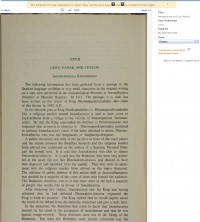 The following footnote appears in his article: For more details and epigraphic evidence of Guru Nanak’s visit to Sri Lanka see S. Karunaratna’s article “Guru Nanak and Ceylon” in Harbans Singh (ed) Perspectives on Guru Nanak, Patiala, 1999. In his paper, the scholar, who is also a noted archaeologist, has examined an inscription in Sanskrit written on a slab, preserved in the Archaeological Museum at Anuradahpura (Sri Lanka) which testifies to the visit of Jananacharya (Nanak Acharya) to Jayavardhanapura during the rule of king Dharmaprakarambahu, a contemporary of Guru Nanak.
The following footnote appears in his article: For more details and epigraphic evidence of Guru Nanak’s visit to Sri Lanka see S. Karunaratna’s article “Guru Nanak and Ceylon” in Harbans Singh (ed) Perspectives on Guru Nanak, Patiala, 1999. In his paper, the scholar, who is also a noted archaeologist, has examined an inscription in Sanskrit written on a slab, preserved in the Archaeological Museum at Anuradahpura (Sri Lanka) which testifies to the visit of Jananacharya (Nanak Acharya) to Jayavardhanapura during the rule of king Dharmaprakarambahu, a contemporary of Guru Nanak.
As per above paper and inscription Guru Nank while visiting Jaywerdhenpur(Kotte)western province; came from , which is located in Eastern Province.Thus these two inscriptions prove that Guru Nanak visited first Batticaloa(Kurukallmadam) under Kingdom of Shiv Nabh (Vijaybahu VII) and then visited Kotte(Jaywerdhenpur) under kingdom of Parakarambahu IX. According to referred site [3] Shiv Nabh was old name of King and is same as Vijaybahu VII , as there was a tradition to adopt kingdom name after coronation prevailing at that time.
NOTES AND REFERENCES
1 Sri Guru Granth Sahib, Amritsar, 1604, Rag Dhanasari, M.I., p. 13.
2 The first Udasi(or missionary journey) extended from 1507 to 1515(to the East); the second from 1517 to 1518 (to the South) and the third one from 1518 to 1521 (to the North) after which he settled down for ashram life at Kartarpur, as an ordinary householder. His last journey was to Achal Batala, Pakpattan, Dipalpur and Multan in 1539 (to the West).
3 Kirpal Singh, Perspectives on Sikh Gurus, (Delhi,1996), p.171. The author is thankful to Kirpal Singh for providing valuable source material relating to the Guru's visit to Sri Lanka and gratefully acknowledges his findings in preparation of this paper.
4 The study of Janamsakhis indicates that at several places only caste, occupation or race, like Uppal (caste), Pathans (race), Karoria (revenue official) etc., is given in order to indicate the person of that class. Kirpal Singh, op. cit., p. 175.
5 Rev. James Cartman, Hinduism in Ceylon (Colombo, 1957), p.41, cited in Kirpal Singh, op. cit., p. 178, fn. 6. For more details see also K.K. Pillay, South India and Ceylon, Madras, 1963
6 Rev, James Cartman, op. cit., p. 35
7 Vide Ceylon Literary Register, September 24,1885, Vol. I, no.7, p. 63
8 Kirpal Singh, op. cit., p 173, fn.9. The vassal states were (1) Mullativa (2) Trincomali (3) Batticoloa (4) Kottiyar (5) Palugana (6) Panam ami (7) Yala.
9 Sir Alfred Lyal, Asiatic Studies (Religious and Social), Vol VI (London, 1899), p.326
10 Kirpal Singh, op. cit., p. 171
11 See Kirpal Singh’s,' Historical Significance of Janam Sakhi of Guru Nanak by Meharban' in Proceedings, Punjab History Conference, Patiala, 1970, pp. 126-27
12 Janam Sakhi Mehrban, p. 104, Kirpal Singh, op. cit., p. 126
13 Robert Needham Cust, "Guru Nanak the Indian Reformer" in Pictures of Indian Life, London, 1881, p.206
14 Sir Denzil Ibbetson and Sir Edward D. Maclagan, A Glossary of the Tribes and Castes of the Punjab and NWFP. VoL I, Lahore, 1919,p. 678
15 Khushwant Singh, A History of the Sikhs, vol. 1, Oxford, Delhi, 1977, p. 33, fn. 19
16 The Manuscript was originally written hi 1811 for Col. David Ochterlony of the East India Company's service. The portion dealing with Guru Nanak is translated from the Ms in the collection of Dr. Ganda Singh and incorporated in 'Sources on-the Life and Teachings of Guru Nanak,' The Panjab Past and Present, Vol. III, Patiala, 1969, pp. 370-76. (16)
17 Ibid p. 373
18 Sir John J.H. Gordon, The Sikhs, London, 1904, p 23
19 Ibid. p. 23, The Gospel of the Guru Granth Sahib, Madras, 1960, p. 286; Ganda Singh(ed.) "Sources on the life and Teachings of Guru Nanak", The Panjab Past andPresent, Vol HI,1969, p.286
20 Ibid, p 286
21 J.C. Archer, The Sikh. A study in Comparative Religion, Princeton, New Jersey, 1946, p.88
22 Ibid., p. 93
23 Ibid.
24 lbid,p.95
25 Archer, Ibid., p.95
26 Gopal Singh, Guru Nanak (New Delhi, 1967), p. 40; Kirpal Singh, Janamsakhi Parampara, Itihasik Drishtikon tun, (Punjabi), Patiala,1969), pp.76-81
27 Ihid
28 Ibid
29 Ihid
30 K.K. Pillay, South India and Ceylon, (Madras, 1963), p, 136
31 C, Sivaratnam, Cultural History and Principles of Hinduism, p.1199, cited in Kirpal Singh, op. cit., p. 175
32 Ibid, p. 176. Ibid. Whatever may be the contents of the Haqiqat Rai Muqam Raja Shivnabh Ki, its purpose, as its title indicates, was to give an account of the route leading to the place of Raja Shivnabh.
33 Anonymous, Journal of the First Voyage of Vascoda Gama, published in the Journal of Royal Asiatic Society, Ceylon Branch,1908, Vol XIX, 1906-7,Colombo, 1908, p. 321
34 For more details and epigraphic evidence of Guru Nanak’s visit to Sri Lanka see S. Karunaratna’s article “ Guru Nanak and Ceylon” in Harbans Singh (ed) Perspectives on Guru Nanak, Patiala, 1999. In his paper, the scholar, who is also a noted archaeologist, has examined an inscription in Sanskrit written on a slab, preserved in the Archaeological Museum at Anuradahpura (Sri Lanka) which testifies the visit of Jananacharya (Nanak Acharya) to Jayavardhanapura during the rule of king Dharmaprakarambahu, a contemporary of Guru Nanak.
